Tomato plants produce some beautiful yellow flowers in the summer, but why exactly do they appear, and should you do anything specific when your tomatoes are flowering? I have been growing tomatoes for many years, and I have written this article to answer those questions and more for you.
Flowering is a natural part of a tomato plant’s lifecycle. The purpose of flowering is to complete the reproductive cycle by producing seeds. Flowering is the first sign that a tomato plant is about to start producing fruit, although the flowers need to be pollinated by bees or otherwise for that to happen.
In this article, I go into more detail about why tomato plants are flowering, what to do, and how to make sure your tomato flowers are being pollinated so that you can get as much fruit from your tomato plants as possible.
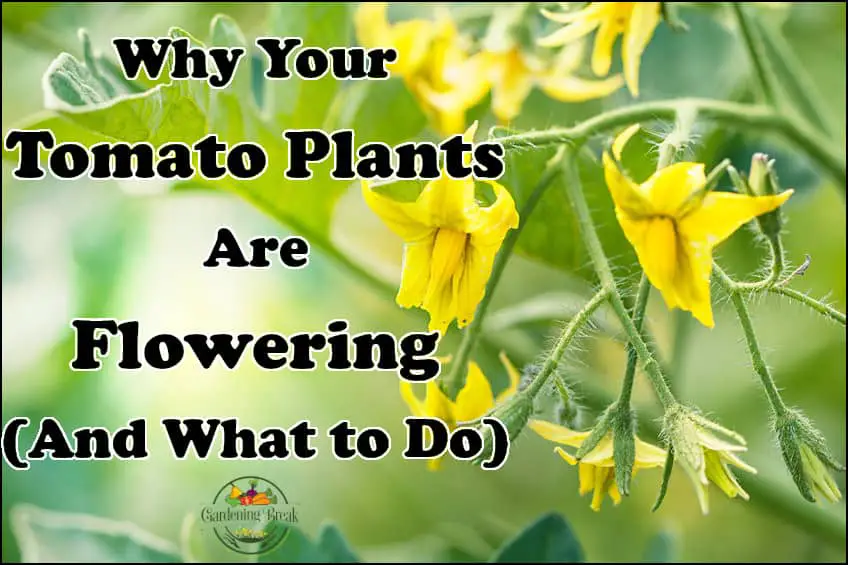
This Is Why Your Tomato Plants Are Flowering
I remember being unsure about why my tomato plants were flowering and specifically about what I should do when it happened when I first started growing tomatoes many years ago. Since then, I have grown a lot of tomatoes and learned a lot about them, so I have written this article to help you out if you are having some of the same questions I had back when I started growing tomatoes.
It is generally a very good sign if your tomato plants are flowering. Flowering means the plant is getting ready to complete its reproductive cycle, which ends with the production of fruit and seeds.
So, flowering is essentially the beginning of the end for your tomato plant. But that is by no means a bad thing because it also means that the plant is getting ready to produce fruit for you to pick, and it will still be around for a while.
Tomato plants will only grow and flower if they have good enough growing conditions, so if yours are flowering and otherwise look healthy, it means that you are doing something right.
While flowering is generally a very good sign, you are not guaranteed any fruit just because there are flowers on your tomato plants. Depending on how and where you are growing them, you might have to do something. I will explain that now.
What to Do When Tomato Plants Are Flowering (Important)
Knowing what to do when your tomato plants are flowering can potentially help you get a lot more fruit from the plants with very little extra effort.
What you should do, if anything, when your tomato plants are flowering depends on a couple of things.
First of all, it depends on where and how you grow your plant, and second of all, it depends on what you prefer.
Tomato flowers need to be pollinated before they can produce fruit.
If you grow your tomatoes outside, the flowers will most likely get pollinated without you having to do anything.
If you grow them inside or in a greenhouse, though, you might have to help them become pollinated. If this is your situation, you can scroll a bit down to the headline “How Tomato Flowers Become Pollinated (3 Ways)“, where I explain how you can help your tomato flowers become pollinated.
I grow a lot of tomatoes in a greenhouse this year, and I am not doing anything to pollinate them other than letting a window and the door stay slightly open. The air circulation created by this is enough to pollinate the flowers (I’ll get more into this in a bit).
Here is a picture of some of my tomato plants from this year, and as you can see, they are producing a lot of fruit without me doing anything to pollinate them. They were still green when I took this photo, so they can be hard to see, but there are a lot.
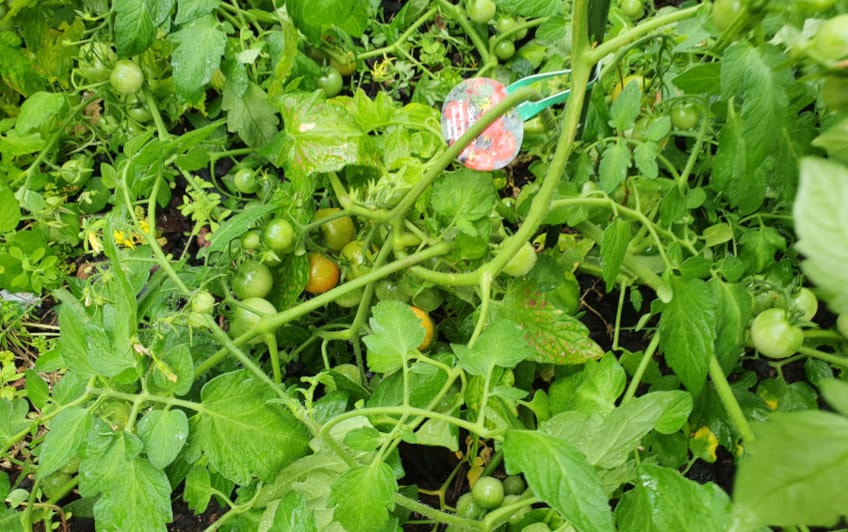
Some people recommend that you remove the first couple of flowers from your tomato plants. The reason is that the plant will begin to spend more energy on flowering and fruit production and less on growing once it begins flowering.
By removing the first couple of flowers as soon as they appear, you can trick the plant into staying in the growing stage for a bit longer, which allows it to get bigger and hopefully produce more fruit overall.
I have tried this some times, and to be honest, I have had very mixed results. Sometimes it seemed like it did make a difference, and other times I couldn’t tell the difference at all, but it is hard to know with certainty how much of a difference it made. It has been some time since I did it now. I just allow my tomato plants to flower when they begin to.
How Long After Flowering Before Tomatoes Appear?
According to this paper by Rhoda Burrows, Professor & SDSU Extension Horticulture Specialist at South Dakota State University, it takes about 30 days from bloom until the fruit reaches its full size and begins to ripen.
How long it takes before you can pick the tomatoes, of course, depends on the variety and on how good growing conditions the plant has. Sunlight, temperature, nutrients, and watering all affect how fast tomatoes grow.
Sometimes you will see that some of the flowers on your tomato plant will dry up and fall off without producing fruit. This can happen for a few reasons, which I will get into now.
Tomato Flowers but No Fruit? The Most Likely Reason
Not all tomato flowers end up producing fruit. It is actually not at all uncommon that the flowers end up falling off without producing any fruit.
It can happen because of poor growing conditions. For example, if the plant doesn’t get enough sunlight or water, but there is a more common reason.
The most common reason tomato flowers fall off without producing fruit is that the flowers have not been pollinated.
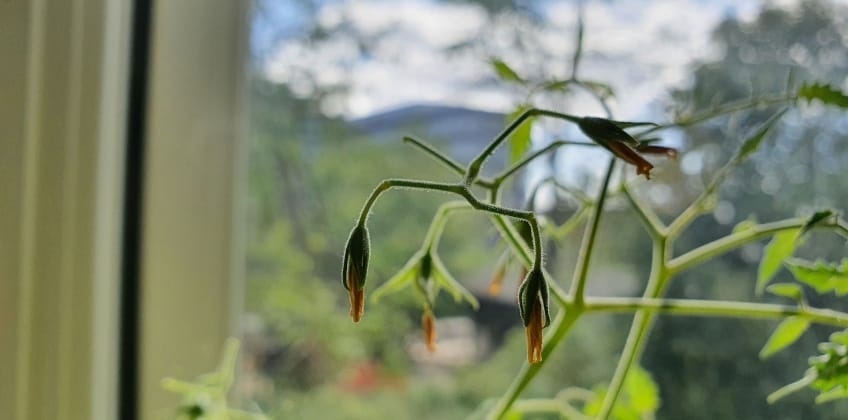
A sign that a tomato flower hasn’t been pollinated and is dying is that the part of the stem just behind it turns yellow. This is what is happening to my tomato flowers in the photo above. It isn’t very clear, but you can see it a bit on the leftmost flower. The very blurry flower in the back actually did get pollinated, and you can see a small tomato forming.
If flowers are not pollinated within about two days, they will fall off. I found a presentation by Monica Ozores-Hampton, Fnu Kiran, and Gene McAvoy from University of Florida that explains why. You can also learn more about the anatomy and morphology of tomato flowers in the presentation. Here is what they say about tomato flowers falling off without producing fruit:
Tomato flowers need to be pollinated within 50 h (2 days), or they will abort and drop off. It takes that long for the pollen to germinate and travel up the style to fertilize the ovary at above 55°F.
Monica Ozores-Hampton, Fnu Kiran, and Gene McAvoy, University of Florida, Blossom Drop and Reduced Fruit Set in Tomato
Since lack of pollination is the most common reason why tomato flowers fall off without producing fruit, I want to teach you how they become pollinated and how you can increase the pollination rate and thereby the fruit production significantly.
How Tomato Flowers Become Pollinated (3 Ways)
Some plants have flowers that are either male or female, and other plants have flowers that are monoecious, which means that they are both male and female at the same time. Tomato flowers belong to this category.
This technically means that tomato flowers can often pollinate themselves without help from anybody, although it doesn’t always happen. Depending on where and how you are growing your tomatoes, you might have to do something to get the most fruit from them.
The male parts of tomato flowers are called anthers, and the female parts are called pistils. The anthers contain the pollen that has to make its way to the pistils before the flower gets pollinated and can produce fruit.
I want to share three ways tomato flowers can get pollinated. After that, I explain how you can make sure that as many of the flowers as possible are pollinated.
Pollination by wind and good airflow
The most common way for tomato flowers to be pollinated is from the wind spreading the pollen from the male to the female parts of the flowers.
Since tomato flowers are monoecious, meaning that they are both male and female at the same time, the pollen doesn’t have to travel very far to pollinate the flowers. The wind is usually enough to move the tomato plants and flowers around enough so that the pollen is spread properly.
If you grow your tomatoes in a greenhouse (I have a lot of tomatoes in a greenhouse this year), you should make sure that there is proper airflow. I do that by keeping a window and the door slightly open in my greenhouse, and I get a lot of fruit from my plants.
Bees, butterflies, and other pollinators
If your tomatoes are growing outside or somewhere that has bees, butterflies, or other pollinating insects, you don’t have to do anything when your tomatoes are flowering. The insects should pollinate the flowers without you having to do anything.
Keep an eye on your plant to make sure there are bees or other pollinators around it. If there are, the flowers should become pollinated. You can read more about that on this link.
Insects that can pollinate tomato flowers include bees, butterflies, bumble bees, wasps, and more.
Manually hand pollinating tomato flowers (3 methods)
If there isn’t so much wind, not a lot of bees or other insects, or you just want to make sure that as many of your tomato flowers become pollinated as possible, you can hand pollinate them. There are a couple of good ways to do this, so let me teach you.
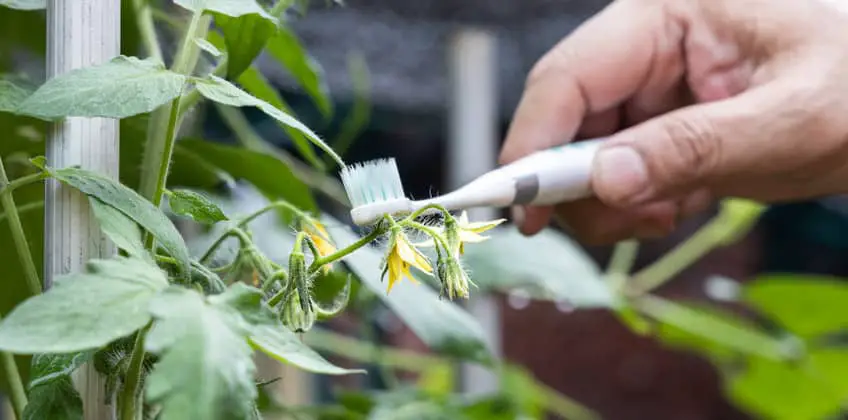
Gently tap your tomato plants to spread the pollen
The easiest way I have found to hand pollinate tomato flowers is to simply tap the plant a couple of times every now and then. Ideally, every day during the flowering phase. This will shake the plant and loosen some of the pollen, which hopefully (and usually) finds its way to the female part of the flowers.
Using a vibrating device for hand pollination
Another easy and effective method for hand pollinating tomato flowers is to use a vibrating device such as a toothbrush. Turn it on so that it is vibrating and gently touch the back of the flowers like in the photo above for a few seconds. This should make the flowers shake or vibrate enough for the pollen to be spread.
Using a cotton swab or fine paint brush for hand pollination
Another method for hand pollinating tomato flowers is to use a cotton swab or a fine paintbrush to collect and spread the pollen. Gently touch the flower everywhere on the petals, anthers, and pistils. You can basically just rub the cotton swab or paint brush all over the inside of the flower to be sure. Just make sure you are being gentle to avoid damaging the flowers.
Some of the flowers will almost always dry up and fall off before they get pollinated, so don’t worry if all of the flowers don’t end up producing fruit. That is perfectly normal and expected. To ensure the best results, though, I want to share a simple trick for checking if the flowers have been successfully pollinated.
Easy Way to Check if a Tomato Flower Has Been Pollinated
You want as many of the flowers on your tomato plants to be pollinated as possible since that means you get as much fruit from the plant as possible. So is there a way to check if a tomato flower has been pollinated successfully?
I have already written a bit about this in another article (which you can find here), but here is what you need to know.
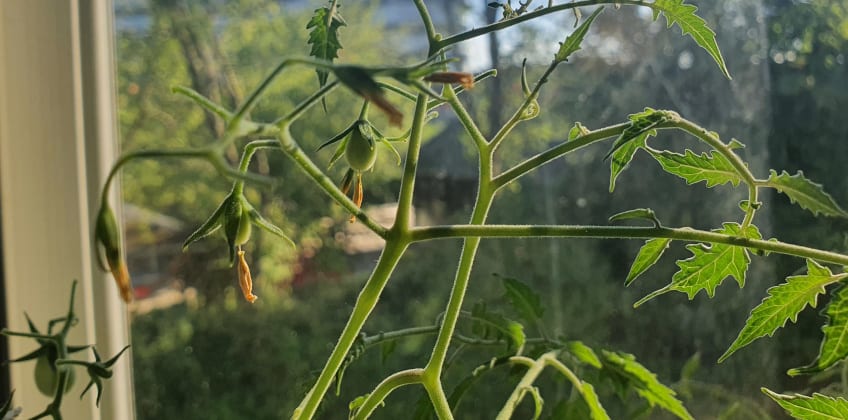
Here are some ways to tell if a tomato flower has been pollinated:
- You can see the stem right behind the flower begin to get larger and round. This is a small tomato that is beginning to form, and you will soon be able to see the actual fruit. That is what you can see in the photo above of one of my plants from this year.
- Look at the stem. If the stem right behind a flower is getting yellow, it means the flower has not been pollinated and is dying. If the stem stays green and the stem right behind the flower begins to get larger, it means that it has been pollinated.
- Look if the flowers are wilting. Wilting usually occurs within a day after the flower is pollinated, so if you see the flowers begin to wilt, it is usually a good sign.
How to Get as Many Tomato Flowers as Possible (3 Tricks)
The more flowers your tomato plants produce, the more fruit you can potentially harvest. That is why I want to share three tricks you can use to maximize the flower and fruit production of your tomato plants.
Plant your tomatoes deep in the ground
Deep planting is one of the easiest and most effective things you can do to get the most out of your tomato plants.
As the name indicates, deep planting essentially just means that you put the plants deeper in the ground than you normally would. This causes roots to grow from all over the parts of the stems that were buried, resulting in a much larger and more comprehensive root system.
This is good because the larger and more comprehensive the root systems get, the more water and nutrients the plants can obtain, which helps them grow and produce fruit.
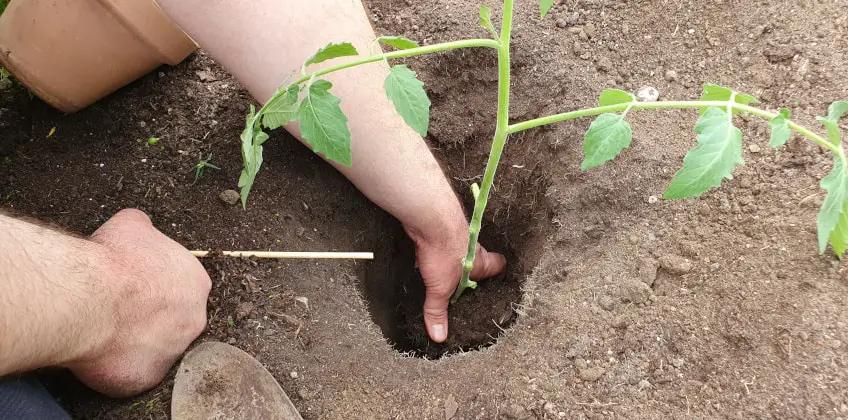
You can read a lot more about why deep planting tomatoes is good on this link, where I also show how to do it step by step. I also have this article, where I share some other tips and methods for planting tomatoes.
Pick a productive variety
Not all tomato varieties produce the same amount of fruit. Some varieties produce significantly more fruit than other varieties, so I recommend that you head over to this article, where I share some tips for picking a productive variety.
If you don’t know what variety your tomatoes are, you can read this article that I have written to help you find out.
Proper growing conditions
Proper growing conditions are crucial for tomato plants to grow and produce fruit, so make sure your plants get a lot of direct sunlight, are watered frequently, and grow in nutrient-rich, well-drained soil.
This isn’t so much of a trick but rather something you should always keep in mind when growing tomatoes.
Does a Tomato Plant Die After It Is Done Flowering?
Even though flowering and fruit production are the last steps in a tomato plant’s reproductive cycle, frost is usually what kills it. Tomato plants usually grow and produce fruit until the first frost in the fall or winter, at which point the plants will succumb to the low temperatures.
In my experience, there are almost always some unripe tomatoes left on the plants at the end of the growing season. Make sure you pick them before the first frost comes since that can ruin the fruit. The internet is full of ideas for what you can use unripe tomatoes for, so don’t let them go to waste.
Tomatoes are almost always grown as annual plants, which means that they only live for a single growing season, but if you live in an area that never gets frost and has enough sunlight to grow tomatoes all year round, you can technically keep the plant alive for up to two years. You can read more about that on this link.
Should You Harvest Tomatoes as Soon as They Are Ripe?
You might be wondering if you should pick your tomatoes as soon as they begin to turn red or if you should wait for all of them to be ripe before you pick them.
I recommend that you pick your tomatoes as soon as they are ripe, no matter if there are also some unripe tomatoes on the plant. Just leave the unripe ones on the plant and pick the ripe ones.
The faster you pick the ripe tomatoes, the faster the plant will free up energy to focus on producing or ripening other tomatoes. You can read more about that in this article.
Harvest early and harvest often. Frequent harvesting is the key to getting a good yield from your tomato plants.

